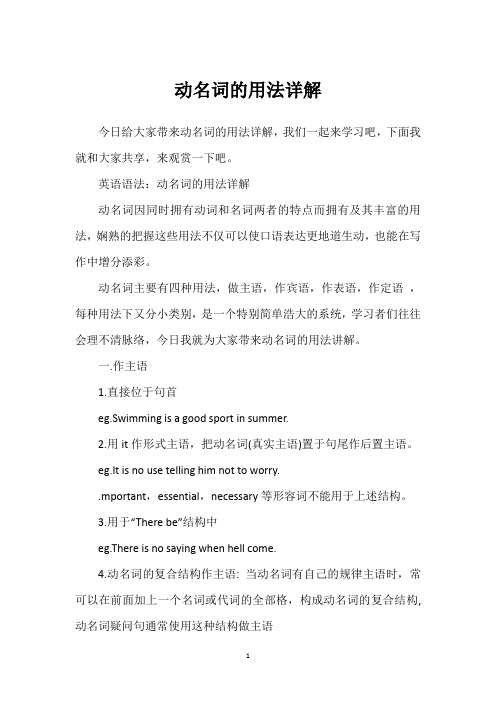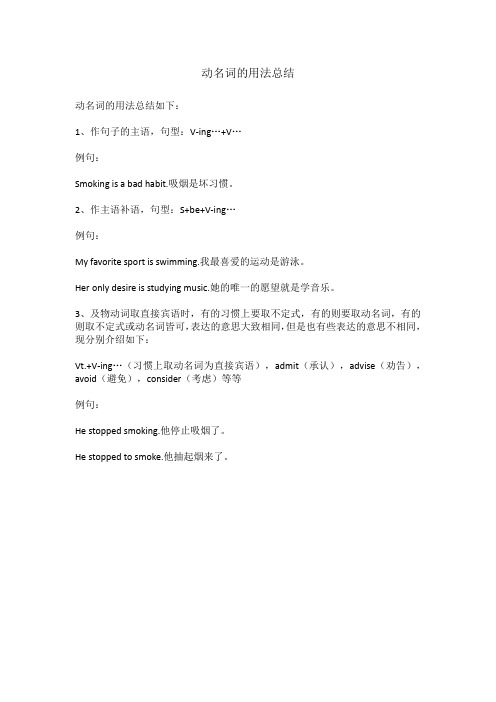动名词做主语的用法
动名词作为句子主语的常见结构

动名词作为句子主语的常见结构1. 简介动名词是以-ing结尾的动词形式,在英语中可以作为名词使用。
动名词作为句子的主语是一种常见的句子结构,本文将介绍动名词作为句子主语的常见结构及其用法。
2. 动名词作为句子主语的结构2.1 基本结构动名词作为句子主语的基本结构为:[动名词] + [谓语动词]例如:- Swimming is good exercise. (游泳是很好的运动。
)- Dancing is her passion. (跳舞是她的激情。
)- Cooking is an art. (烹饪是一门艺术。
)2.2 同位语结构动名词作为句子主语还可以与一个名词或代词形成同位语结构,此时动名词引导的短语起到说明、解释或补充主语的作用。
[动名词] + [名词/代词] + [谓语动词]例如:- His hobby is swimming. (他的爱好是游泳。
)- Her job is teaching. (她的工作是教书。
)- My interest is learning languages. (我的兴趣是研究语言。
)2.3 提问结构动名词作为句子主语还可以用于提问结构。
[Wh-疑问词] + [is] + [动名词] + [谓语动词]?例如:- What is swimming good for? (游泳有什么好处?)- Where is dancing performed? (跳舞在哪里表演?)- Why is cooking considered an art? (为什么烹饪被认为是艺术?)3. 动名词作为句子主语的用法3.1 表示一般概念动名词作为句子主语可以表示一般概念或抽象事物。
例如:- Playing music brings me joy. (演奏音乐给我带来了快乐。
)- Reading books is a great way to relax. (阅读书籍是一个很好的放松方式。
)3.2 表示惯或爱好动名词作为句子主语可以表示惯或爱好。
动名词的用法详解

动名词的用法详解今日给大家带来动名词的用法详解,我们一起来学习吧,下面我就和大家共享,来观赏一下吧。
英语语法:动名词的用法详解动名词因同时拥有动词和名词两者的特点而拥有及其丰富的用法,娴熟的把握这些用法不仅可以使口语表达更地道生动,也能在写作中增分添彩。
动名词主要有四种用法,做主语,作宾语,作表语,作定语,每种用法下又分小类别,是一个特别简单浩大的系统,学习者们往往会理不清脉络,今日我就为大家带来动名词的用法讲解。
一.作主语1.直接位于句首eg.Swimming is a good sport in summer.2.用it作形式主语,把动名词(真实主语)置于句尾作后置主语。
eg.It is no use telling him not to worry..mportant,essential,necessary等形容词不能用于上述结构。
3.用于“There be”结构中eg.There is no saying when hell come.4.动名词的复合结构作主语: 当动名词有自己的规律主语时,常可以在前面加上一个名词或代词的全部格,构成动名词的复合结构,动名词疑问句通常使用这种结构做主语eg.Their coming to help was a great encouragement to us.Does your saying that mean anything to him?二.作宾语1.作动词的宾语某些动词后消失非限定性动词时只能用动名词作宾语,不能用不定式。
不定式通常指某种特定的动作,但动名词表示泛指,常见的此类动词有:admit,appreciate,excuse,stand,advise,allow,permit,avoid,consider,enjoy,f inish,give up,cannot help,imagine,include,keep,understand,keepon,mind,report,risk,miss,put off,delay,practise,resist,suggest,depend on,think about,set about,succeed in,worry about,burst out,insist on,feel like,be used to,get used to,devote…to…,look forward to,pay attention to,get down to,escape and so on.eg.They went on walking and never stopped talking.他们连续走,说个不停。
动名词用法总结

动名词定式用法小结动名词是一种非谓语动词形式,其结构为“动词原形+ ing”。
形式上与现在分词一样,但与现在分词有很大区别。
动名词既具有动词特点,又具有名词特点。
动名词词在句子中可以用作主语、表语、宾语、补足语、定语、状语等。
一、作主语1、动名词是由动词变化而来,所以,动名词的意义也是表示某个动作或事情。
例如:ReadingEnglish aloud in the morning will do you a lot of good.Cheatingon an exam ruins one'scharacter.考试作弊毁坏人的性格。
2、动名词作主语时,对于一些比较长的动名词短语,一般采用"It is…"和"There is…"两种句式来表示。
例如:It is no usewaiting for him any longer.等他是没有用的。
Thereis no joking about suchmatters.这种事开不得玩笑。
3、动名词作主语与不定式作主语的区别:动名词作主语通常表示抽象的或泛指的动作,一般不与特定的动作执行者联系在一起;不定式作主语通常表示具体的动作或行为,往往与特定的动作执行者联系在一起,如:抽象)It’s no use crying over spilt milk. (He realized that to go on like this was no use. (具体)4、在实际运用中,一般可以互换,差异不大。
但在下列几种情况中不能互换:当表语是动名词时,主语也要用动名词;当表语是不定式时,主语也要用不定式,如:Seeing is believing. = To see is to believe.5、动名词和不定式作主语,一般都可以使用形式主语it,而将动名词或不定式放在句尾。
但是在下列句型中,一般宜用动名词,不宜用不定式来代替:It’s no use doing …It’s no good doing…It’s a waste of time doing …二、作表语1、动名词作表语与现在分词作表语的区别:动名词作表语时相当于名词,说明主语的含义及内容,它与主语是同等关系,主语与表语互换位置不影响句子的基本含义,但不可用副词来修饰。
动名词的用法总结详解英语语法

动名词的用法总结详解英语语法动名词词在句子中可以用作主语、表语、宾语、补足语、定语、状语等。
以下是店铺为大家整理的动名词的用法,希望能帮助大家更好地掌握动名词,提高英语水平。
动名词的用法:作主语1、动名词是由动词变化而来,所以,动名词的意义也是表示某个动作或事情。
例如: Reading English aloud in the morning will do you a lot of good.Cheating on an exam ruins one's character. 考试作弊毁坏人的性格。
2、动名词作主语时,对于一些比较长的动名词短语,一般采用"It is …"和"There is …"两种句式来表示。
例如:It is no use waiting for him any longer. 等他是没有用的。
There is no joking about such matters. 这种事开不得玩笑。
3、动名词作主语与不定式作主语的区别:动名词作主语通常表示抽象的或泛指的动作,一般不与特定的动作执行者联系在一起;不定式作主语通常表示具体的动作或行为,往往与特定的动作执行者联系在一起,如:It’s no use crying over spilt milk. (抽象)He realized that to go on like this was no use. (具体)4、在实际运用中,一般可以互换,差异不大。
但在下列几种情况中不能互换:当表语是动名词时,主语也要用动名词;当表语是不定式时,主语也要用不定式,如: Seeing is believing. = To see is to believe.5、动名词和不定式作主语,一般都可以使用形式主语it,而将动名词或不定式放在句尾。
但是在下列句型中,一般宜用动名词,不宜用不定式来代替:It’s no use doing … It’s no good doing…It’s a waste of time doing …动名词的用法:作表语1、动名词作表语与现在分词作表语的区别:动名词作表语时相当于名词,说明主语的含义及内容,它与主语是同等关系,主语与表语互换位置不影响句子的基本含义,但不可用副词来修饰。
动名词的用法总结

动名词的用法总结
动名词的用法总结如下:
1、作句子的主语,句型:V-ing…+V…
例句:
Smoking is a bad habit.吸烟是坏习惯。
2、作主语补语,句型:S+be+V-ing…
例句:
My favorite sport is swimming.我最喜爱的运动是游泳。
Her only desire is studying music.她的唯一的愿望就是学音乐。
3、及物动词取直接宾语时,有的习惯上要取不定式,有的则要取动名词,有的则取不定式或动名词皆可,表达的意思大致相同,但是也有些表达的意思不相同,现分别介绍如下:
Vt.+V-ing…(习惯上取动名词为直接宾语),admit(承认),advise(劝告),avoid(避免),consider(考虑)等等
例句:
He stopped smoking.他停止吸烟了。
He stopped to smoke.他抽起烟来了。
动名词的用法_英语语法

动名词的用法动名词是一种兼有动词和名词特征的非限定动词。
它可以支配宾语,也能被副词修饰。
动名词有时态和语态的变化。
一、动名词的作用动名词具有名词的性质,因此在句中可以做主语、表语、宾语、定语等。
1、做主语Reading is an art. 读书是一种艺术。
Climbing mountains is really fun. 爬山是真有趣。
Working in these conditions is not a pleasure but a suffer. 在这种工作条件下工作不是愉快而是痛苦。
动名词做主语,有时先用it作形式主语,把动名词置于句末。
这种用法在习惯句型中常用。
如:It is no use/no good crying over spilt milk. 洒掉的牛奶哭也没用。
It is a waste of time persuading such a person to join us. 劝说这样的人加入真是浪费时间。
2、作宾语(1)作动词的宾语某些动词后出现非限定性动词时只能用动名词作宾语,不能用不定式。
常见的此类动词有:advise, allow, permit, avoid, consider, enjoy, finish, give up, cannot help, imagine, include, keep, keep on, mind, miss, put off, delay, practice, resist, suggest, depend on, think about, set about, succeed in, worry about, burst out, insist on, can’t stand, be used to, get used to, devote…to…, look forward to, pay attention to, get down to等。
动名词的用法 英语语法
动名词的用法动名词是一种兼有动词和名词特征的非限定动词。
它可以支配宾语,也能被副词修饰。
动名词有时态和语态的变化。
一、动名词的作用动名词具有名词的性质,因此在句中可以做主语、表语、宾语、定语等。
1、做主语Reading is an art. 读书是一种艺术。
Climbing mountains is really fun. 爬山是真有趣。
Working in these conditions is not a pleasure but a suffer. 在这种工作条件下工作不是愉快而是痛苦。
动名词做主语,有时先用it作形式主语,把动名词置于句末。
这种用法在习惯句型中常用。
如:It is no use/no good crying over spilt milk. 洒掉的牛奶哭也没用。
It is a waste of time persuading such a person to join us. 劝说这样的人加入真是浪费时间。
2、作宾语(1)作动词的宾语某些动词后出现非限定性动词时只能用动名词作宾语,不能用不定式。
常见的此类动词有:advise, allow, permit, avoid, consider, enjoy, finish, give up, cannot help, imagine, include, keep, keep on, mind, miss, put off, delay, practice, resist, suggest, depend on, think about, set about, succeed in, worry about, burst out, insist on, can’t stand, be used to, get used to, devote…to…, look forward to, pay attention to, get down to等。
动名词作主语的用法
动名词作主语的用法动名词是现在分词的一种形式,在句子中可以作为主语。
以下是动名词作主语的用法:1. 作为主语动名词可以作为句子的主语。
例如:- Swimming is good exercise.(游泳是一项很好的运动。
)- Running is his favorite hobby.(跑步是他最喜欢的爱好。
)2. 带有不定式的动名词动名词可以与不定式连用,表示一个动作或行为。
例如:- His goal is to learn to play the guitar.(他的目标是学会弹吉他。
)- My dream is to travel around the world.(我的梦想是周游世界。
)3. 带有介词的动名词动名词可以与介词搭配使用。
常见的介词有 for, in, on, at, with 等。
例如:- Thank you for helping me.(谢谢你帮助我。
)- She is interested in learning new languages.(她对研究新语言很感兴趣。
)- He is good at playing basketball.(他擅长打篮球。
)4. 带有名词性限定词的动名词动名词可以与名词性限定词连用,限定词可以是形容词或名词。
例如:- Her favorite activity is shopping.(她最喜欢的活动是购物。
)- The best part of traveling is experiencing new cultures.(旅行最好的一点是体验新的文化。
)动名词作为主语的用法具有灵活性和表达能力强的特点,可以用于描述各种不同的动作、行为和情况。
通过使用动名词作为主语,可以使句子更加生动和有趣。
动名词做主语的用法
动名词的用法一. 动名词做主语的用法动名词做主语往往表示经常性、习惯性的动作, 在口语中也可以表示具体的动作。
如:Se eing isbelievin g.Helpingher is m y duty.Talkingmends no holes.空谈无济于事。
Worki ng withyou is a pleasur e. 和你一起工作是一种乐趣。
动名词做主语和不定式做主语一样,也可以用it作形式主语。
如:It's rat her tiri ng walki ng aroun d in a c ity.不定式做主语往往表示具体的特别是将来的动作。
如:It's nouse cryi ng overspilt mi lk. 覆水难收。
H e realiz ed thatto go on like th is was w rong. (指具体动作)二. 动名词作宾语的用法1.有些动词或短语动词后常用动名词作宾语。
如adm it, appr eciate,avoid,ca n't stan d(不能忍受), conside r,delay, devote… to, di slike en joy,esca pe, excu se, feel like, f inish, f orgive,get down to, giv e up, i magine.insiston, keep (on), l ook forw ard to,mention, mind,m iss(错过), pay att ention t o, pract ice, put off, st ick to,suggest等等。
动名词 举例
动名词举例动名词是英语语法中的一个重要概念,在英语中起着多种语法和语义的作用。
本文将对动名词进行详细的阐述,包括其定义、用法、特点以及举例等方面,旨在帮助读者更好地理解和掌握动名词的用法。
一、动名词的定义与用法动名词是动词变形的一种形式,在句子中可以作名词使用。
动名词的构成方式为动词+ing(如:walking、talking),其主要有以下几种用法:1.作主语:动名词作主语时,通常指一种习惯性或经常性的行为,如:“Running is good for your health.”(跑步对健康有益)。
2.作宾语:动名词作宾语时,表示动作或者状态被实施,如:“I enjoy swimming in the summer.”(夏天我喜欢游泳)。
3.作介词的宾语:动名词作介词的宾语时,常常用于介词的后面,如:“He is interested in playing basketball.”(他对打篮球很感兴趣)。
4.作定语:动名词作定语时,多与名词连用,起修饰限定的作用,如:“A shopping mall is a good place to relax.”(购物中心是一个休闲的好地方)。
二、动名词的特点动名词具有以下几个特点:1.可数与不可数:动名词可以数和不可数,具体是由与其搭配的冠词,量词或表量的形容词来决定。
2.与动词之间的区别:动名词和动词在形式上是相似的,但在语义和用法上有所区别,读者应该注意区分。
3.逻辑主语的形式:在动名词短语中,逻辑主语的形式决定了动名词的格位。
三、动名词的具体用法举例接下来,我们将从各个方面对动名词的用法进行举例阐述,旨在帮助读者更好地理解和掌握动名词的用法。
1.习惯性行为:Doing exercise is good for your health.(锻炼对健康有益)。
2.动作或状态被实施:I love cooking.(我喜欢烹饪)。
3.与介词搭配:She is fond of reading.(她喜欢阅读)。
- 1、下载文档前请自行甄别文档内容的完整性,平台不提供额外的编辑、内容补充、找答案等附加服务。
- 2、"仅部分预览"的文档,不可在线预览部分如存在完整性等问题,可反馈申请退款(可完整预览的文档不适用该条件!)。
- 3、如文档侵犯您的权益,请联系客服反馈,我们会尽快为您处理(人工客服工作时间:9:00-18:30)。
动名词的用法. 动名词做主语的用法动名词做主语往往表示经常性、习惯性的动作 , 在口语中也可以表示具体的动 作。
如: Seeing is believing.Helping her is my duty.Talking mends no holes. 空谈无济于事。
动名词做主语和不定式做主语一样,也可以用 it 作形式主语。
如 :It's rather tiring walking around in a city.不定式做主语往往表示具体的特别是将来的动作。
如It's no use crying over spilt milk. He realized that to go on like this was wrong. (. 动名词作宾语的用法escape, excuse, feel like, finish, forgive, get down to, give up, imagine. insist on, keep (on ), look forward to, mention, mind,miss ( 错过), pay attention to, practice, put off, stick to, suggest等。
Doing morning exercises is good for your health.做早操对你的健康有好处。
Her shoes wants mending.Working with you is a pleasure.和你一起工作是一种乐趣。
覆水难收。
指具体动作 ) 1( 有些动词或短语动词后常用动名词作宾语。
如admit, appreciate, avoid can't stand ( 不能忍受 ), consider ,delay, devote …to, dislike enjo y ,她的鞋该修理了。
注意: 当need, want, require, worth 后面接doing 也可以表示被动。
Your hair wants cutting.你的头发该理了。
The floor requires washing.地板需要冲洗。
I have finished writing this book.我已经写完这本书了。
2. 在allow, advise, forbid, permit 后直接跟动名词作宾语,如果有名词或代词作宾语,则构成“ allow,advise,forbid,permit ,名词,代词,不定式(宾语补足语)”之形式。
如:We don't allow smoking here(We don't allow anybody to smoke here(3. 动词need, require, want 意为“需要”时,后跟动名词的主动式或不定式的被动式作宾语,意义没有区别。
如The window needs,requires,wants cleaning,to be cleaned( 4. 在begin, continue, love, like, hate, prefer, intend, start 后用动名词和用不定式作宾语均可,意义没有多大区别。
5. 动词forget, go on, mean, regret, remember, stop, try, be used to,can't help 后跟动名词和跟不定式区别较大,须注意。
forget, regret, remember 后跟动名词,动名词表示已经发生的动作; 后跟不定式表示将要发生的动作。
go on doing 继续做原来做的事go on to do 接着做另一件事mean doing 意味着要做某事mean to do 想要做某事stop doing 停止做某事stop to do 停下来(别的事)开始做某事try doing 试着做某事try to do 努力做某事be used to doing 习惯于做某事be used to do 被用来做某事can't help doing 禁不住做某事can't help to do 不能帮助做某事三(-ing 形式作主语和宾语的用法Translate the following sentences into Chinese.1. Talking to him is talking to a wall.2. Smoking may cause cancer.3. Walking is my sole exercise.4. Talking mends no holes.5. I suggest bringing the meeting to an end.6. He admitted taking the money. 他承认钱是他拿的。
7. I couldn 't help laughing.我禁不住笑了起来。
8. Your coat needs brushing.你的大衣需要刷一下。
-ing 形式作定语, 宾语补足语和表语的用法四、-ing 形式作定语1. 单个动词的-ing 形式作定语位于被修饰名词的前面,既可以表示被修饰者的作用或功能,也可以表示被修饰者的动作或状态。
如building materials= materials for building 建筑材料drinking water= water for drinking 饮用水a walking stick= a stick for walking 手杖a reading room= a room for reading 阅览室a writing desk= a desk for writing 写字台tiring music= music that is tiring 烦人的音乐a surprising result= a result that is surprising一个惊人的结果2. -ing 形式短语作定语时, 放在所修饰的名词之后, 并且在意思上相当于个定语从句。
如:They lived in a room facing the street.= They lived in a room that faces the street.他们住在一间面朝街的房子。
The man standing there is Peter 's father.= The man who is sta nding there is Peter 's father.站在那儿的那个人是彼得的父亲。
Anybody swimming in this river will be fined.= Anybody who is swimming in this river will be fined.在这条河里游泳的任何一个人都会被罚款。
3. -ing 形式短语也可以用作非限制定语,相当于一个非限制性定语从句,这时,它与句子其他部分用逗号分开。
如His brother, working as a teacher, lives in Beijing.= His brother, who is working as a teacher, lives in Beijing.他那个当教师的哥哥住在北京。
The apple tree, swaying gently in the breeze, had a good crop of fruit.= The apple tree, which was swaying gently in the breeze, had a good crop of fruit.那棵苹果树硕果累累,在微风中轻轻摇曳。
五、-ing 形式作宾语补足语1. 1)动词-ing形式作宾语补足语常放在宾语后面,表示一个正在进行的主动性的动作,强调一个过程或一种状态。
如When we returned to the school, we found a stranger standing at the entrance.当我们回到学校时, 发现一个陌生人站在大门口。
We found the snake eating the eggs.我们发现蛇正在吃鸡蛋。
I found a bag lying on the ground.我发现地板上放着一个包。
The boss kept the workers working the whole night.那老板让工人整夜地工作。
2) 当主句转换为被动结构时, 原来作宾语补足语的动词-ing 形式便转换为主语补足语。
如:They found the result very satisfying.= The result is found very satisfying.这个结果很令人满意。
They heard him singing in the next room.= He was heard singing in the next room.有人听到他在隔壁房间唱歌。
We mustn't keep them waiting.= They mustn ' t be kept waiting.千万不能让他们等。
2. 能用-ing 形式作宾语补足语的几类动词:1) 表示感觉和心理状态的动词,常见的有see, hear, feel, smell, find,notice, observe,look at, listen to 等。
如:We saw a light burning in the window.I felt somebody patting me on the shoulder.Can you smell anything burning?As he spoke, he observed everybody looking at him curiously.Listen to the birds singing.I d idn ' t notice him waiting.2) 表示指使意义的动词,常见的有have, set, keep, get, catch, leave等。
如:、-ing 形式作表语六-ing 形式作表语时放在系动词之后,用来泛指某种动作或行为,以说明主语的身份、性质或情况。
如:Her hobby is painting.她的业余爱好是画画。
My job is looking after the children.我的工作就是照顾这些孩子。
